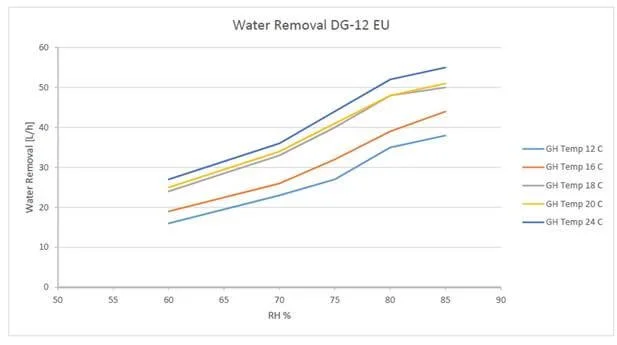What are the Ideal Humidity and Temperature Set Points for Greenhouse Growing?
The optimal humidity and temperature set points for greenhouse cultivation are:
Relative humidity level around 80%
Temperature range of 18ºC – 24ºC (night – day, 64ºF – 75ºF)
Optimal Greenhouse Humidity – Why ~80% Relative Humidity?
Relative humidity is a critical climate parameter in the cultivation of any crop. So most growers aim to maintain optimal humidity ranges, corresponding with the plants they grow.
The optimal relative humidity setpoint for most plants is around 80%. At this level, growth rates are highest for common greenhouse plants. At higher or lower humidity levels, plant physiological processes may slow down, leading to slower growth and lower quality output.
High relative humidity levels also drastically increase the susceptibility to common humidity diseases such as botrytis or powdery mildew.
Humidity is a climate parameter that growers should understand, control and maintain to suit their target crops, rather than simply attempt to reduce it to a minimum.
Optimal Greenhouse Temperature – Why 18°C (64°F)?
Most common greenhouse crops require a temperature range of around 18º-24ºC (64ºF – 75ºF).
These temperatures are considered optimal for most common crops, which is why we find them in most greenhouses around the world. Temperatures outside of this range would normally lead to slower or halted growth and suboptimal crop quality, which is why growers rarely stray from it.
Controlling humidity in greenhouses and indoor growing facilities is a necessity. As untreated humidity, in such settings, leads to major problems and inefficiencies. When crops experience conditions that aren’t optimal to them, they grow slower, smaller, and their quality is reduced.
Unchecked humidity will cause condensation inside any facility. The presence of this free water leads to the development of diseases such as botrytis and downy mildew, which can rapidly destroy large amounts of vegetables, cannabis or any other crop.
Example of Water Extraction Rate Graph
The following graph presents the water extraction rate of the new DG-12 EU unit, at temperatures ranging from 12ºC to 24ºC (64ºF – 75ºF).

The Y-axis represents water removal rates in liters per hour, while the X-axis represents relative humidity levels.
We can see that extraction rates rise as temperature and the relative humidity rise.
Under optimal greenhouse conditions of 80% relative humidity and 18ºC, the unit removes 48 liters of water per hour. At higher temperatures, the unit extracts water at a higher pace.
DryGair Provides Optimal Humidity and Temperature for Common Greenhouse Conditions
DryGair is one of the only dehumidifier manufacturers with the sole focus of humidity control for agriculture. The units provide an optimal humidity reduction at common cultivation conditions of 18ºC and 80% relative humidity. This helps DryGair operate efficiently, extracting more than 4 liters (1 gallon) per kWh.
As a solution for greenhouses and indoor cultivation, DryGair units should operate during specific problematic periods:
- When heating and venting is not possible without incurring heat losses
- During the night – from dusk to dawn (read about homogeneous & consistent climate condition)
- When outdoor relative humidity is higher than indoors (i.e. rain, humid seasons)
Spikes in relative humidity can cause dewpoint condensation, leading to the development of various diseases. DryGair’s humidity control solution is designed to avoid these peaks, which are most common during dusk and dawn when conditions outdoors change rapidly.
DryGair is a humidity control tool for horticulture, providing a high water extraction rate:
- Up to 48 liters per hour (13 gallons) at 18ºC (64ºF), 80% relative humidity.
- Overnight extraction accumulates to 576 liters (152 gallons)
All DryGair operational data is measured at 18ºC (64ºF) and 80% relative humidity. Water extraction rates are faster at higher temperatures and relative humidity levels.





